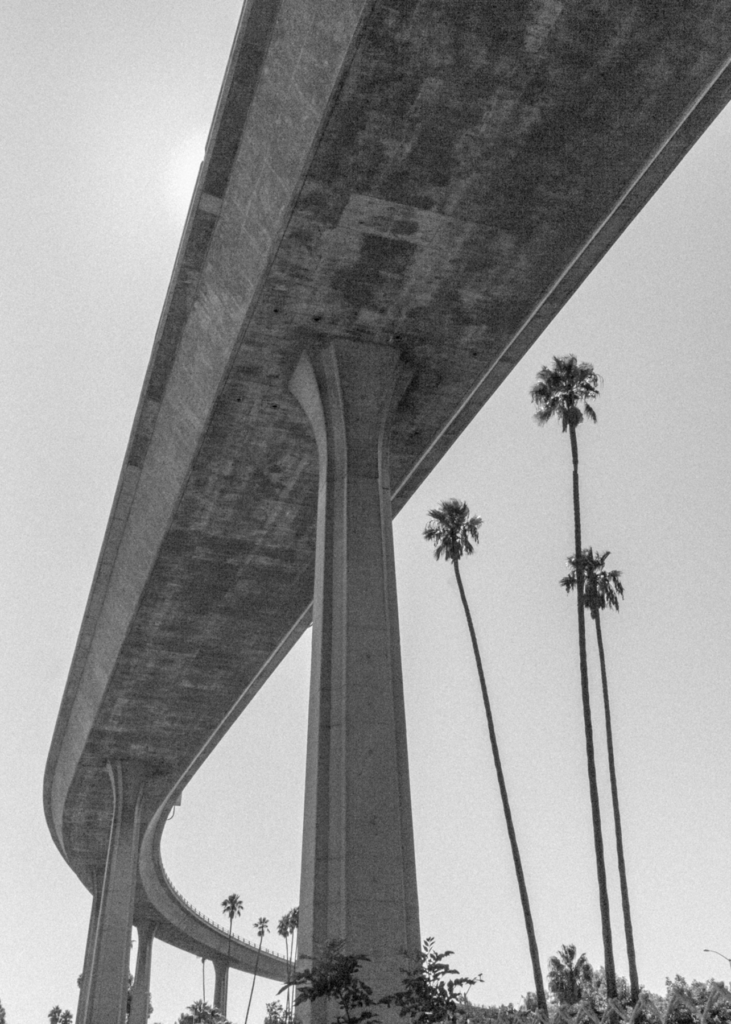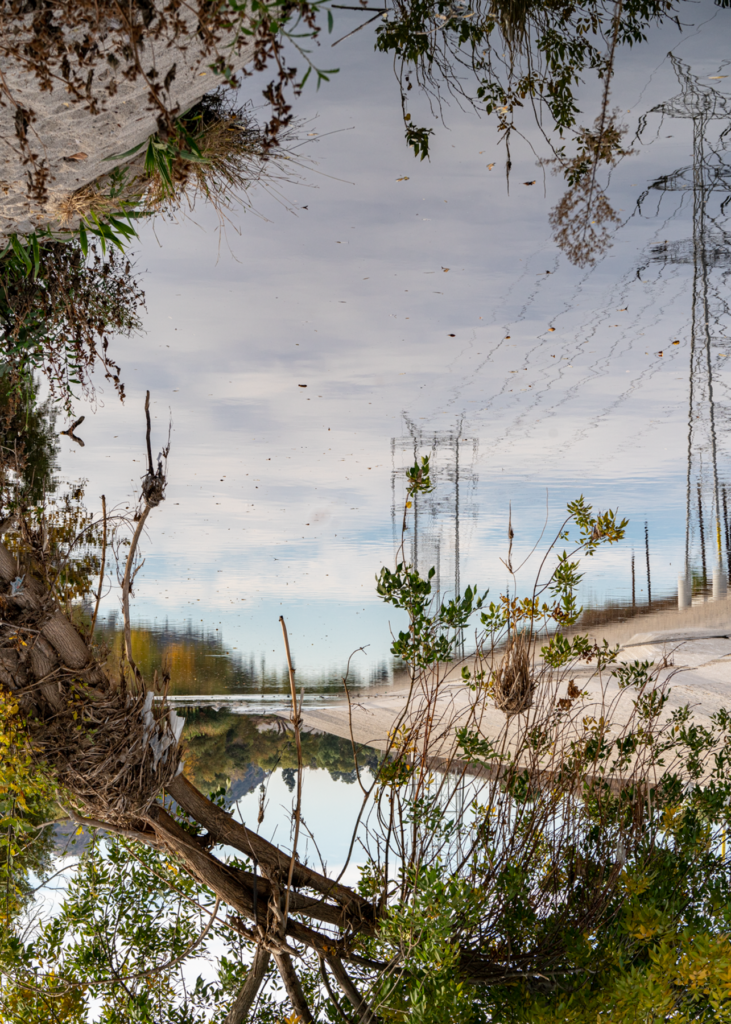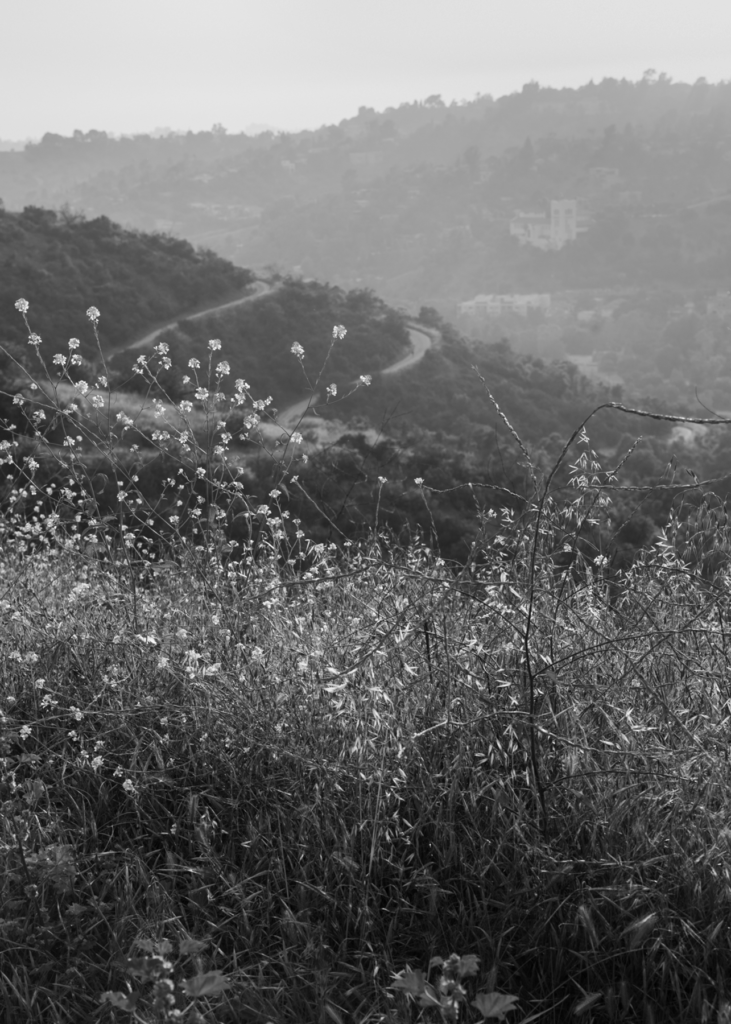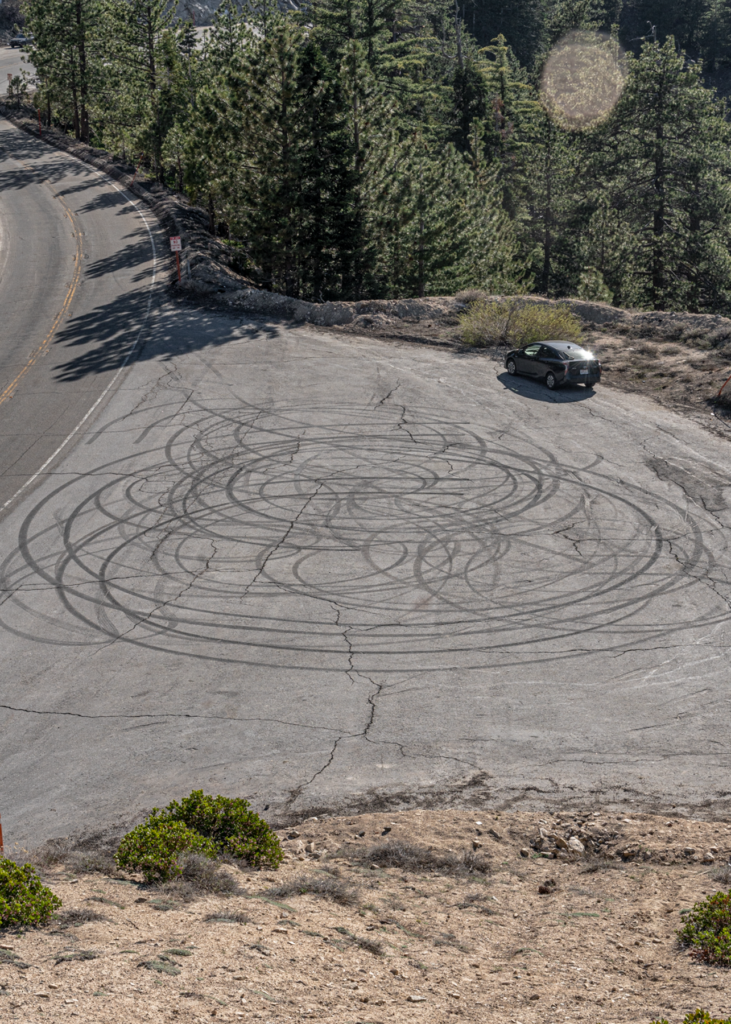In this excerpt from his acclaimed new book, Everything Now: Lessons From the City-State of Los Angeles, author Rosecrans Baldwin assesses the deeper meaning of this invented and provisional city.
7.8 One winter night, a London actress threw a party in a cliffside house in the Hollywood Hills. Guests sat on a white rug next to a wood-burning stove. The doorbell rang, and the actress squealed with delight when a deliveryman arrived with a large bag stained by oil, full of McDonald’s fries. The actress, a short woman, recognizable from television, thrust her arm into the bag nearly all the way to the shoulder. “Oh, they’re the best, you must try,” she murmured. Afterward, she smoked a cigarette on the terrace. The view was grandiose and glittering. Vermont Avenue, crammed with cars all the way to Long Beach, was two long ropes of lights. “You know, L.A. isn’t really a city, it’s too spread out,” the actress said. She shrugged and frowned. “Honestly, it’s terrible. Do you know? Los Angeles magnifies everything, it really does. It completely magnifies the worst in yourself. I mean, I do love it, I love it, but I hate it.” Recently, the actress had been out of work, I learned. The house atop the canyon had been borrowed from a friend. “Monday, the Emmy’s, can I tell you? I was completely suicidal. All these people more successful than you, younger than you. Mental. And everyone so facetious. You want to know the city? It’s addicts and storytellers, that’s all.” A dog trotted outside. The actress picked it up in her arms. Half Chihuahua, half pug, her “companion chug,” she called it. She said in a soft voice, “I’ll tell you what Los Angeles is: it’s nothing. It doesn’t exist.”
Sometimes, when I really hated Los Angeles, I thought the actress was right. All the suffering and concrete added up to zero or less, as Bret Easton Ellis would have it — a sun-blasted nothing, a brainless amoeba with vital forces seeping in and out of the body public in some dysfunctional communion. “A place has to become an inner landscape for the imagination to start to inhabit that place, to turn it into its theatre,” the Italian novelist Italo Calvino wrote when he lived in Paris. But what happened when the play was a dud? What if it was a flop?
One Sunday I attended a Gnostic rite in the dark basement rooms of a strip mall near Verdugo City. During the ceremony, each member of the congregation approached the altar to accept the Eucharist while submitting to a naked woman sitting on an altar. It was strange, though more humdrum than anything, to stand at eye level with a woman’s vagina, surrounded by burning candles, and accept the blood of Jesus Christ (a shot glass of wine) and the body of Jesus Christ (a snickerdoodle, I think) and salute her womanhood. (Afterward, the clergy served a champagne brunch.)

On another morning I listened to messages from outer space with the Aetherius Society, a group that believed in UFOs, and afterward they served a champagne brunch, too, but only because it was someone’s birthday. And one evening, after some difficulty wrangling an invitation, I was scheduled to meet a sect of Real Vampires, or vamps — people who enjoy drinking the blood of others, or having their blood consumed — at a pizza restaurant in the Valley for happy hour, but I couldn’t find them. (They look just like everybody else.) Thankfully they offered to reschedule, and we met at a bar in Hollywood, enjoyed beer and chicken wings, and I learned many things, like, “You can have a platonic donor-vamp relationship, but once you’ve fed two to three times, you form an intimate connection.” The woman who told me this was, by day, a nurse practitioner. Her donor, sitting next to her, added, laughing, “It’s because they want to play with their food.” I bring all of this up because sometimes the city-state was interminably dull but also endlessly interesting. It could feel like a hotel sometimes, like Mars sometimes, and sometimes like a hotel on Mars where Marleen Sundgaard’s grandchildren lived in a furnished suite next to Elon Musk’s cyborg offspring.
Los Angeles: was an exercise in horror vacui.
Los Angeles: was algae from the future.
Los Angeles: ate at the dream side of my mind.
7.9 As I looked over these propositions in aggregate, adding up the hours spent transcribing and thinking about people’s feelings and thoughts, some facts became apparent, if the city-state didn’t want to collapse. It needed to educate its children much better. It should become a more desirable place to do business while investing more heavily in public health and transit — affordable housing, methods of mobility, ways of sharing our richest amenities with more citizens.
Most of all, Los Angeles rapidly needed to address the breach between the wealthy and everyone else. The so-called middle class had disappeared, and a new type of feudalism seemed to be hardening into place. In the summer of 2020 the novelist Héctor Tobar wrote in an opinion piece, “I missed the earnestness and naiveté of the happy, sunburnt, flabby, and unpretentious Angeleno middle class. I missed the feeling that we were all equal, somehow: not just in the Constitutional, Enlightenment sense of that word, but also in the backyard California party sense of being comrades in relaxation gathered around barbecues and inflatable kiddie pools.”
And no matter what anyone did, the basin would continue to burn, crack, and roil, and the streets again would be covered in ash. The climate crisis had us and would have us worse. Those who lived here would be weird and homogenized, they’d find their surroundings inspiring and despairing. And for at least a little while longer, to its credit, Los Angeles would remain North America’s eclectic doom-brain plasticity test, where so much was still up for grabs: a reverie on demographics and cultural trends; the final acts of a play about the villainies of property-based politics; a road crew working on the future where almost anybody could grab a shovel. “This is where you come if you want to have one foot on solid ground and one foot on ground that shakes a lot,” the cultural historian and USC professor Josh Kun told me. “There’s an edginess here that’s geological, psychological, and creative. You can have a freedom here that you might not be able to have in other places in the U.S. If that means you’re living in your own country, I think there’s something to that.”

This book never intended to wear a Dodger cap. The history of Los Angeles doesn’t lack for boosters, and depictions continue to be overly optimistic or pessimistic. Disasters — pandemics, earthquakes — pause human time, and the lucky survive. Our health was improving; our health was critical. The smog had improved and then begun to slip drastically, especially in neighborhoods that weren’t wealthy. Meanwhile, housing costs had gotten so high, residents were among the United States’ most cost burdened. “We’ve been a city of houses, and we’ve abandoned the majority of our population to being housing precarious, housing-burdened, or homeless,” Dana Cuff, the architecture theorist at UCLA, told me. “Our schoolteachers can’t afford to be here — there’s something fundamentally wrong about that.”
A place of layers. A place of palimpsest. A place of loss. To paraphrase the Swedish statistician Hans Rosling, the existence of the city-state often seemed to be “better and bad” at the same time, was how I’d come to think of it. Or, as the Los Angeles Times columnist Steve Lopez put it in the paper one morning, “Los Angeles is a singular, inspired mess, paradise lost and found, prone to natural catastrophe and too chaotic and leaderless to be neatly assessed as getting better or worse. It’s always doing some of both, and like any work in progress, it’s in greater need of critics than defenders.”
7.10 Sometimes “better and bad” was most evident when a long effort at justice was accomplished. On an autumn morning, one of the city-state’s most notorious criminals sat through his sentencing trial. Downtown, on the stuffy ninth floor of the Clara Shortridge Foltz Criminal Justice Center, maybe half a dozen reporters were in the first row of a wood-paneled courtroom while the next row overflowed with family members of the victim, Terry Carter, known as “Pops,” killed in 2015 at the age of fifty-five. And in the final two rows were what seemed to be friends and relatives of the defendant, fewer in number despite his fame. The defendant’s father appeared to sit in front of me, the defendant’s sister next to me — both identifications based on photos I quickly found with my phone. Nearby sat a young man with a cursive tattoo on his neck: KnightLife.
“We’ve been here ninety-three days, make this ninety-four days,” one of Carter’s daughters said. That morning was the trial’s final get-together, and the victim’s family had been invited to offer impact statements. Members were told to direct their comments to the judge, not the accused, who sat nearby in an orange jumpsuit, though most of their comments sounded meant for the accused, and some were addressed that way.
“You don’t run over somebody and run back over them and not know what you’re doing,” Carter’s brother-in-law said at one point. One relative read aloud from a letter written by Carter’s wife. “‘When my husband’s name is Googled, you don’t see videos of our wedding,’” he read. “‘What you do see is the defendant kill my husband.’” Carter was described in the newspaper as a paternal figure, helping young men avoid gang life. The defendant, Marion Hugh “Suge” Knight Jr., represented a glorification of gang culture, in a way that had enriched him while being marketed to millions.

One relative talked about the violence the defendant had done conceptually to Los Angeles, specifically to Compton, the Carters’ city within the city, which the accused had helped make famous in his image. Family members said the defendant hadn’t even apologized to them, hadn’t shown remorse. “I hope and I pray that we can find forgiveness,” one of Carter’s cousins said, “but it won’t be today.”
Carter’s death took place at a branch of Tam’s Burgers, a local fast-food chain, on Rosecrans Avenue. Knight had been in a fight with another man, allegedly tried to drive him over with his truck, and struck Carter instead. In the courthouse, the judge assigned Knight twenty-eight years. The woman near me, whom I took to be his sister, said quietly, “Oh no . . .” An hour later, the atmosphere at Tam’s was quiet. A man in a business suit ate a burrito. A work crew in reflective vests ate burgers and fries. Compton lay low under bright sunlight. Businesses were busy, lawns were kept. A young man with a towel over his shoulder pushed a baby carriage and nodded when I passed. The Pacific Ocean lapped endlessly some twelve miles west.
“You know, the biggest misconception is when America looks at these people, they think it’s all just one personality,” Kendrick Lamar, the Compton local and Pulitzer Prize–winning rapper, said in a 2016 documentary. “It is a sense of optimism. It’s moving forward in certain directions. I think a lot of kids out here, they recognize the talent and the potential that we all have.”
7.11 What can be said of the United States often can be said most clearly about Los Angeles. Historically, the city-state had often suggested where not only the American city was headed but also the American people, with all their Americanness. All gig workers now, all climate refugees now. All of us trapped, consciously or not, by our racist past and policies. It is probably too soon to know, but perhaps the coronavirus outbreak of 2020 will be a catalyst for other cities to grow more nation-like and challenge the primacy of the state as the era of globalism disintegrates and power devolves to local levels.
At the same time, Los Angeles was not the United States in miniature, like Houston, Chicago, or New York. Always an invented city, L.A. was creating a new type of city-state as we watched, internet version or otherwise, one that would yield to time and manipulation and social clash, of course, but also would offer a study on what tomorrow’s communal urban living might look like. If anything, as the century approached its quarter mark, Los Angeles felt to my mind like the rawest, large-scale example still running of the American experiment — a self-made place attracting self-made people, though one where diversity and dispersion were significant assets, not figments of a dream.
“It’s really more unusual than common that people from radically different backgrounds share a society together peacefully,” Kit Rachlis, the former editor-in-chief of Los Angeles magazine and LA Weekly, told me. “Other cities have their many layers of immigrants, too. But in L.A., not only are we all connected; we are also part of this large experiment. New York, Paris, Chicago, those places are still changing, but the pace is slow and the people who change them are encrusted. Here, there’s a sense that any of us could change it. That’s pretty wonderful.”
Under the soft SoCal light, small differences dissolved, car stereos throbbed, a sense of tension persisted from monotony and difference sitting side by side. Rachlis’s comment echoed something that Jade Chang, the novelist from Northridge, once told me: Los Angeles is a place where people get to choose their own experience. If you’re in the middle of Manhattan, you walk out the door “and the city is right in front of you, take it or leave it.” But in the city-state, she felt, you could make a life where you lived in a canyon, and that was it, or on a block in East L.A. that you never left—wherever you were, there was your piece of the polycentrism, enclaved.
7.12 If there is a predominant feeling in the city-state, it is not loneliness or daze, but an uneasy temporariness, a sense of life’s impermanence: the tension of anticipation while so much quivers on the line. Ethnic division, ethnic celebration. Haves, have-nots. Industrial decline, industrial revival. Terror of plague and fear of earthquake, but also the comfort of seeing neighbors help neighbors in Skid Row. For all of L.A.’s apparent selfishness, benevolence seemed to be a local trait. At rush hour one afternoon, on a 780 bus from Olympic to Pasadena, 75 percent of passengers thanked the driver before they disembarked. The next day, on the 110, one driver let another pass, and both waved. At Dodger Stadium, during the coronavirus pandemic, while one of its massive parking lots was converted into what was possibly the world’s largest free testing and vaccination center for COVID-19 — staffed largely by volunteers from a nonprofit agency co-founded, in a particularly Hollywood-ish twist, by the actor Sean Penn — person after person thanked the volunteers for playing their part.
Nothing is fixed. Each evening unveils yet one more hypnotic sunset, and still L.A. remains a “provisional city,” in the words of Dana Cuff, so old but young, same-seeming but miscellaneous, planned but given to chance, with more to come.

Nearly a decade before moving to California, my partner Rachel and I lived in France, where I listened to episodes of Good Food, a radio show produced by KCRW in Santa Monica. At the time, I had few connections with Los Angeles, but I loved the conversations between the host, chef Evan Kleiman, and a local food writer, Jonathan Gold. Gold wasn’t yet the first food critic to win a Pulitzer Prize, but a writer known for crisscrossing L.A. County in search of great meals. And it was the way that he talked about the region, rather than its restaurants, that made me want to visit — the idea that Los Angeles was a vast kingdom of vast interest. Kleiman once said in an interview in the newspaper, “Do you know how many people have told me that when they moved here, they had no idea how to deal with Los Angeles? And they used [Gold] as a template to learn the city. It made them flip from being afraid and kind of not happy to be here to embracing it.”
Gold died from pancreatic cancer in 2018 at the age of fifty-seven. The day after, I drove around Los Angeles to eat three of his favorite Mexican dishes: smoked marlin tacos in Inglewood, a shrimp taco in Boyle Heights, the clayuda at an Oaxacan restaurant in Koreatown. At the last stop, a family of tourists speaking French waited by the valet stand. It was their first time visiting, the father said. They loved the beaches, the different neighborhoods, the variety of people. “It’s, how do you say, just so American.” I was reminded of how even France had felt the same that year, when Le Bon Marché, the grand Parisian department store, had designed its annual Christmas theme around a Southern California aesthetic, complete with vintage motorcycles and a skateboard ramp. “We used to hear a lot about New York in the past,” Jennifer Cuvillier, the store’s fashion director, said. “Now it’s more and more about Los Angeles.”
Frequently, cities bypass their nations on critical issues. All around the world, there was a sense early in the century that we lived in the prehistory of a new age, and here came Los Angeles: a shifting mosaic of human potential. An all-hours diner, real, surreal, so real. “Let Pauline be Irene. Let you be Beeton. And let me be Los Angeles” (James Joyce, Finnegans Wake). Gone was the suburban era, expansion was limited while blocks stratified, and yes, the city-state continued to offer, for those who might cast it as a microcosm of the United States, probably the best place to watch America unfold before we all permanently moved onto the internet. But it was so much more than that — no other place quite so thrillingly itself, with so many stories lying around untouched. “There are a lot of things that are true of Los Angeles that are also true of other American cities,” Héctor Tobar told me. “But in no other American cities are those truths as evident as they are in Los Angeles.”
“The thing that people find hard to understand, I think, is sort of the magnitude of what’s here,” Jonathan Gold says at one point in City of Gold, a documentary about his life. “The huge number of multiple cultures that live in the city who come together in this beautiful and haphazard fashion. And the fault lines between them are sometimes where you find the most beautiful things.”